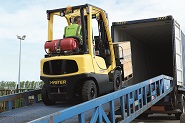“The Hyster business is now structured to focus more on the user’s application rather than the Hyster product groups,” says Ian Melhuish, VP Product and Industry Solutions Group, Hyster. “This is an important change that simplifies and enhances the buying experience with solution packages for specific users.”
Through a new structure, Hyster now operates with “Solutions Teams” and smaller sales management areas. Armed with new tools, the deeply experienced “solutions providers” aim to provide customers with the right product, and related services, at the right price.
To illustrate these changes, Ian gives four examples in different industries. In each example, the customer needs a truck with a 2.5 tonne lift capacity, but each solution is very different.
Paper mill and store
A busy paper mill may typically need a compact truck with a 2.5 tonne capacity to carefully handle paper rolls in production and storage areas with limited space. The Hyster S2.5FT space-saving truck, featuring a 1.43m wheelbase, gives excellent turning radius in these tight areas. With a 500mm load centre and a RTST (Return To Set Tilt) function to ensure that rolls are set down level to avoid damage, the Hyster SpaceSaver forms part of a proven package for the paper industry.
Local Freight/Transport business
In contrast, a small local transport business loading and unloading pallets from curtain sided lorries over a single shift may require a simple, tough truck. In this case, price and reliability may be more important, with the Hyster 2.5CT providing the power and strength it needs to get the job done quickly, at the right price.
ConstructionMaterial production and distribution site
However, some environments can damage a forklift engine. Supplied as part of a pan-European agreement, at one particular site where building materials are produced, 2.5 tonne diesel trucks transfer palletised materials from production to warehouse racking and outside storage areas. With heavy duty air filters and protection technologies, the Hyster Fortens H2.5FT trucks are fully protected from the effects of fine abrasive concrete dust.
The male and female drivers are also continually under productivity pressures to prevent bottlenecks at the end of the line, so the trucks are fitted with fully enclosed cabs, heaters, fingertip controls and lighting to ensure they are comfortable and alert for the duration of a shift in all weathers, at any time of day.
Temperature controlled storage areas at a port
At many ports, general stevedoring and freight handling companies discharge ships loaded with fresh produce. They need maximum availability from the forklift fleet as the ships have to be turned around quickly and the produce sorted straight away. In many cases the produce is transferred immediately into temperature controlled stores or cross docked to transport.
Ultra reliable Hyster H2.5FT LPG powered trucks, fitted with sideshift, are used for continuous operation to ensure a 24 hour flexible service. The featured Duramatch™ transmission enables even the most aggressive direction changes to be made smoothly, without using the brake pedal or even stopping the truck. This contributes to improved productivity and reduced maintenance costs, prolonging the lifetime of the clutch, brakes and tyres, particularly on the quayside.
“Dating back to the 1920s, Hyster has continuously developed a global reputation for manufacturing tough trucks combined with excellent support,” says Ian. “However, these examples show how different applications require different solutions. We have structured the business in parallel with our customers’ requirements, providing both product and non product solutions to reduce their cost of operations.”
Hyster has carefully selected a worldwide network of local distribution partners, based on the strength of their customer support capability and outstanding service ethic to provide expert consultancy in line with these changes, and responsive local service and parts supply.



